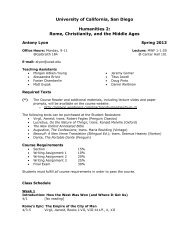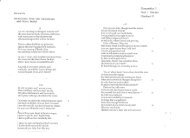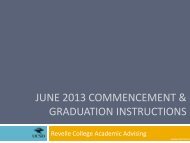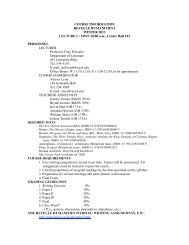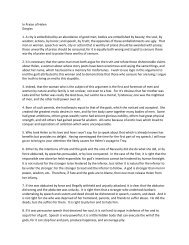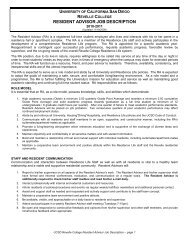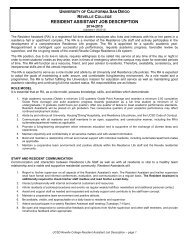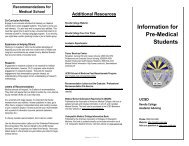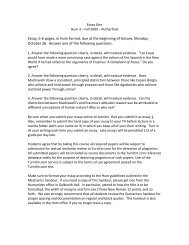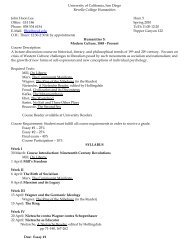Hum 1 Syllabus 12 - Revelle College
Hum 1 Syllabus 12 - Revelle College
Hum 1 Syllabus 12 - Revelle College
You also want an ePaper? Increase the reach of your titles
YUMPU automatically turns print PDFs into web optimized ePapers that Google loves.
Prof. S. Chodorow<br />
Office Hour: Thurs. 9:30-10:30<br />
and by appointment<br />
Office: HHS 6059<br />
Email: schodorow@ucsd.edu<br />
HUMANITIES 1<br />
<strong>Syllabus</strong><br />
Prof. Stanley Chodorow<br />
Winter 20<strong>12</strong><br />
On the <strong>Hum</strong>anities Sequence<br />
The <strong>Hum</strong>anities Sequence introduces you to the European cultural tradition. From the<br />
early years of the nineteenth century to the mid-1970s, Americans regarded that tradition<br />
as THE tradition. Educated Europeans and Americans considered “Western”—i.e.<br />
European—civilization as the best civilization ever created. They thought that Judaeo-<br />
Christian values were the culmination of human moral development, and European<br />
civilization dominated the world through empires that competed politically and<br />
economically but that all represented a single cultural heritage. Through much of the<br />
nineteenth and twentieth centuries, Europeans and Americans thought that this<br />
domination represented the true relationship among the world’s civilizations and that it<br />
was a permanent relationship. Even after the empires began to break up following World<br />
War II (1939-45), Europeans and Americans thought that they had civilized the colonial<br />
elites, if not the common people, and that the emerging independent nations would be<br />
subordinate members of the European cultural empire that would survive the political<br />
one.<br />
Since the 1970s Americans, more than any other group, have changed their perceptions<br />
about the world’s cultures. First, they have come to recognize that the cultural traditions<br />
of China, India, and Islam are equivalent to the European-American tradition, and also to<br />
appreciate the effect of exchanges of ideas and material goods on all civilizations. No<br />
civilization grew up in isolation; none can claim to have invented all their characteristic<br />
elements. Second, other cultures, in Africa, Southeast Asia, and Central Asia among<br />
other places, have reasserted themselves and acquired some respect among westerners.<br />
Third, the society of the United States, and for that matter of European countries, has<br />
become much more culturally diverse than it was in the 1950s and 1960s, and<br />
Americans’ attitude towards civilization in general and European civilization in particular<br />
has changed.<br />
Right after World War II, Americans thought that they were the heirs of European<br />
civilization. They thought that in its American form European civilization would be
<strong>Hum</strong>anities 1 <strong>Syllabus</strong>, Chodorow, Winter 20<strong>12</strong>: 2<br />
saved from the Europeans, who, notwithstanding their civilization, had tried to destroy<br />
one another in two world wars. Americans thought that they would carry on the old<br />
civilization without sliding into the racism and wanton destructiveness that had been<br />
evident in the Europe of the fascists, Nazis, and communists. Of course, we thought all<br />
these noble thoughts while practicing racism at home and while fighting wars in Korea<br />
and Vietnam. However, the point is not to expose our delusions. It is to highlight our<br />
cultural ideology. That ideology had produced a peculiarly American approach to<br />
education, and <strong>Revelle</strong> <strong>College</strong>’s <strong>Hum</strong>anities Sequence is a product of that approach.<br />
How do we justify a five-quarter sequence focused exclusively on European civilization<br />
in light of the transformations of American society and culture wrought by the civil rights<br />
movement and the new, massive immigration during the second half of the 20 th century?<br />
There are two answers to this question.<br />
The first arises from the prehistory of the course. The faculty members who created the<br />
<strong>Hum</strong>anities courses were deeply influenced by the University of Chicago, where many of<br />
them had been students or faculty members before they came to UCSD. Chicago was the<br />
first major university to challenge the Eurocentric tradition in American higher education<br />
by insisting that students study at least two traditions, the western or European and<br />
another—Asian, Islamic, or African. In that curriculum, the study of the European<br />
tradition shifted its emphasis from the study of Europe as a master civilization to the idea<br />
of cultural tradition, of which European culture was one among many. The founding<br />
faculty members of <strong>Revelle</strong> <strong>College</strong> were certainly Eurocentric in their outlook, but they<br />
recognized that one of the important features of the course was that it taught students<br />
about cultural traditions.<br />
The second answer to the question is that, in our time, when both faculty members and<br />
students challenge the hegemony of the European tradition, the value of studying and<br />
understanding cultural traditions has become one of the goals of education. The new<br />
American society and culture that is being formed around us and by us is an emerging<br />
amalgam of cultural traditions. Each of these traditions is strikingly strong; people raised<br />
in them cling tightly to their values, modes of personal relationships, arts, foods, and<br />
moral ideas. So, we must understand how traditions form and work, how they absorb<br />
influences from other traditions, how they resist challenges, how they relate to political<br />
and economic systems.<br />
The <strong>Hum</strong>anities Sequence approaches this need by introducing you to one of the<br />
principal traditions in more depth than most introductory courses. The assumption of the<br />
course is that you will be able to understand all traditions, when you study them, if you<br />
have learned to understand one of them. The experience of your faculty and of the<br />
students who came before you justifies this assumption. You will find that once you have<br />
completed the <strong>Hum</strong>anities Sequence, you will gain knowledge of other civilizations more<br />
quickly and more deeply than you would have had you approached them without a grasp<br />
of what a tradition is and how it functions.
<strong>Hum</strong>anities 1 <strong>Syllabus</strong>, Chodorow, Winter 20<strong>12</strong>: 3<br />
What do I mean by a tradition? The word “tradition” means literally a handing down of<br />
ideas and practices from one generation to another. The way your parents teach you to<br />
interact with others—with your parents themselves and other elders, with siblings, with<br />
friends, with classmates, with enemies—derives from a tradition that can be traced back<br />
for generations in your family and in families from a similar cultural background. Within<br />
each tradition there are sayings, stories, ways of doing things (preparing food, practicing<br />
religion etc.), and works of art that people within the tradition regard as emblematic. Do<br />
you want to know what the tradition is? Study those things; the tradition is conveyed in<br />
them. In the <strong>Hum</strong>anities, we focus on literature of different kinds, in part because literary<br />
works are the most public or shared conveyers of cultural tradition and in part because<br />
literature reveals in its stories, characterizations, and descriptive passages many of the<br />
private conveyances of culture. Literature, broadly understood to include philosophy and<br />
religious texts as well as what we now call fiction, is a rich source of knowledge about<br />
the formation and content of a tradition.<br />
On <strong>Hum</strong>anities 1<br />
The European cultural tradition formed from two roots, one in Greece and the other in the<br />
Near East, in the cultures of the Greeks and the Jews. The two root traditions came<br />
together in the culture of the later Roman Empire, the period after 300 C.E. (Common<br />
Era). So, the study of the European tradition must begin with the traditions of the Greeks<br />
and the Jews, the subject of the first quarter of <strong>Hum</strong>anities. (<strong>Hum</strong>anities 2 begins with<br />
the Romans.)<br />
Both the Greek and the Jewish traditions began to form in the twelfth century B.C.E.<br />
(Before the Common Era), and both rest on literary works compiled or written down<br />
centuries later. These writings rested on long oral traditions—the transmission of stories<br />
about the history of the people passed on by mouth from generation to generation. In<br />
both cases the writings in which we can first discover the tradition captured a portion of<br />
the oral culture and shaped it into a coherent picture of society and the way people were<br />
supposed to behave in it. Each tradition presented a world view—a notion about how the<br />
world came to be and what constituted good and bad behavior. Each defined the<br />
characteristics of the culture’s notions of ideal persons and what the culture expected of<br />
people. Each found a way to explain the mysterious ways of the world: What powers<br />
controlled it? What was the place of mankind in it? Why did some succeed and some<br />
fail? Why did one people win wars and another lose them? What were the proper roles<br />
of men and women? What was the relationship between parents and children? These<br />
questions and others will be the subjects of this course and of the whole <strong>Hum</strong>anities<br />
Sequence.<br />
A note on dating: We will use C.E., the Common Era, and B.C.E., Before the Common<br />
Era, instead of B.C., Before Christ, and A.D., Anno Domini (in the year of our lord). The<br />
transition from one era to the other is the same in both systems – the supposed birth of<br />
Jesus – but B.C.E./C.E. is now preferred because it appears to be culturally neutral.<br />
Because it is useful to have common dating, historians of Islam, China, India, and other<br />
cultures use this dating convention, even though each culture has its own calendar
<strong>Hum</strong>anities 1 <strong>Syllabus</strong>, Chodorow, Winter 20<strong>12</strong>: 4<br />
system. That the unified system is the Christian European one is a result of European<br />
world dominance in the nineteenth and twentieth centuries. We might have used the<br />
Islamic system in which year 1 equals 622 C.E. or the Chinese in which year 1 equals<br />
either 2697 or 2637 B.C.E, but, for better or worse, European Christians managed to<br />
establish their calendar as the “common” one. B.C.E. and C.E. make this establishment a<br />
little more palatable to those of other civilizations. (In addition, A.D., Anno Domini, is<br />
not appropriate as a designation of a period – decade, century etc. – because it means “in<br />
the YEAR of the lord.” It can be properly used only when naming a year, such as 20<strong>12</strong><br />
A.D.)<br />
Communications<br />
I have not given you a phone number, because my campus office does not have a phone.<br />
Communicate with me by email. I will try to answer messages quickly—though if you<br />
drop me a note at 2AM, don’t expect an answer until the next morning.<br />
Office Hour: I have set up an official office hour, Thursday 9:30-10:30—i.e. before class.<br />
I will hold office hours at the coffee cart at Mandeville Hall, but I will meet you<br />
elsewhere on campus, including in my campus office in HSS, if you make an<br />
appointment to see me outside of office hours. I know that the office hour conflicts with<br />
other classes and work schedules for some students. I’ll be happy to make an<br />
appointment to see you at another time during the week. Set up an appointment by email.<br />
Students generally think of office hours as occasions when they can come complain or<br />
ask questions about an assignment or deal with some issue, such as handing a paper late<br />
because they were ill or their computer crashed. That attitude is understandable, but I ask<br />
you to consider office hours as an opportunity to chat with me and keep me company. I<br />
like to drink my coffee with someone to talk to. And, if you have to turn in a paper late,<br />
talk to your TA, not to me. I don’t manage that aspect of the course.<br />
Occasionally, I will communicate with the class by email to make an announcement or<br />
inform you of something you should know. The TED platform has your UCSD email<br />
addresses in it, so I’ll be communicating with you through that address. If you do not<br />
use UCSD email as your primary mailbox, and be sure to set a forwarding command in it<br />
so that you get my messages.<br />
The Components of the Course<br />
This course has three main components: Lectures, discussion sections, and readings.<br />
I will assign readings for each lecture, and if you have not read the materials listed for a<br />
lecture, you may find yourself lost when I’m talking about them.<br />
I believe that geographical orientation is important. The societies that produced the<br />
Hebrew bible, the Homeric poems, and classical Greek drama existed in space and time.<br />
I think it is necessary that you understand the geography of the events. So, I will put
<strong>Hum</strong>anities 1 <strong>Syllabus</strong>, Chodorow, Winter 20<strong>12</strong>: 5<br />
maps on the web site and will have maps in some classes. I have created my own<br />
historical “atlas” for the course, based on digital versions of physical maps. All of the<br />
maps I use in class will also be on the web site, so you can look at them at your leisure.<br />
I’ll expect you to know the geography of the Mediterranean and of the Near East.<br />
Class Web Site: The class web site contains the syllabus, the maps, other course<br />
materials, and announcements. There will also be a discussion board to permit you to<br />
post questions for me, for the TAs, and for your fellow students on the readings, lectures,<br />
and any other course materials. My intention is to give you an opportunity to ask<br />
questions or make comments as they occur to you. I will check the discussion board<br />
frequently, if I find that you are using it.<br />
Class Projects: During the course, I will post brief documents, usually from the assigned<br />
readings, on Google Docs and ask you to post comments the document(s). These group<br />
projects have two purposes. First, I want to help you learn how to read the assignments<br />
critically—paying attention to details, asking questions, not taking things for granted.<br />
What is written is not necessarily true or consistent or sensible. Second, I want you to<br />
generate questions and issues I deal with in lecture. I want part of my lectures to be<br />
devoted to responding to you, so I’ll use the comments on the posted documents when I<br />
prepare lectures.<br />
Technical Assistance: If you need some technical assistance with the web site, you can<br />
email the Instructional Web Development Center (iWDC): iwdc@ucsd.edu. Students<br />
often ask me for help, but I am, relative to most of you, a techno-peasant. You are better<br />
off seeking help from iWDC.<br />
Grading in the course will be based on your participation in discussion section and the<br />
completion of all assignments—the papers and the final exam. To pass the course, you<br />
must complete all assigned work and participate actively in discussion sections.<br />
The assignments will consist of four papers and a final exam. We will comment on but<br />
not grade the first paper. We want you to get an idea of what we expect of you as writers<br />
before we give you grades. Each successive paper will weigh more than its predecessor<br />
as a percentage of your course grade. You will see the breakdown below.<br />
We will also assign a grade for participation in section. The success of the sections<br />
depends on your being there and on your participation. I will ask the TAs to record<br />
attendance. If you must miss a section meeting, you should contact your TA to explain<br />
the absence.<br />
We will provide a study guide for the final exam. It will be posted on the web site at<br />
least one-week before the exam. All of the questions asked on the exam will be on the<br />
study guide, so you will be able to prepare answers. However, you will not be able to<br />
bring written materials to the exam; the exams are not take-home exams. We will<br />
monitor the exam for cheating.
<strong>Hum</strong>anities 1 <strong>Syllabus</strong>, Chodorow, Winter 20<strong>12</strong>: 6<br />
The <strong>Hum</strong>anities courses use Turnitin.com(tm) to review the textual similarity of<br />
submitted papers with external sources. The purpose of the review is to detect<br />
plagiarism, so that grades reflect the quality of each student's own work.<br />
Turnitin.com(tm) maintains a database of all submitted papers solely for the purpose of<br />
detecting plagiarism in such papers. The service does not use the database for any<br />
commercial purpose other than detection of plagiarism and in no way restricts the<br />
authors' commercial rights or use of the papers.<br />
Many students who are caught plagiarizing claim that they were merely negligent in<br />
keeping track of bibliographical information on the sources they used. Negligence is not<br />
an excuse. Obviously, we will make a judgment about the seriousness of the offence, but<br />
you should know that even a small amount of plagiarized text can lead to a serious<br />
penalty, both disciplinary and academic.<br />
If you have any problem understanding what plagiarism is, look at the UCSD Student<br />
Handbook. You’ll also find a very good, clear statement on plagiarism on the Princeton<br />
University web site (www.princeton.edu/pr/pub/integrity).<br />
If you are caught cheating on the exam or plagiarizing parts of a paper, we may treat the<br />
assignment as if it had not been submitted at all. If that happens, you will automatically<br />
fail the course, because you must submit all assignments to pass the course. An F for<br />
cheating is permanently recorded on your transcript; it is not a good thing.<br />
We will compute your course grade based on the following weighting of assignments.<br />
(Note that even though we will not assign a grade or weight for the first paper,<br />
which we’ve designated the Ungraded Paper, you must hand it in to pass the course.<br />
However, you will not have to submit the Ungraded Paper to Turnitin.com.):<br />
Ungraded Paper 0%<br />
Paper 1: 10%<br />
Paper 2: 20%<br />
Paper 3: 25%<br />
Section: 10%<br />
Final Exam: 35%<br />
Course Calendar:<br />
Lectures: Tues.-Thurs., 11AM-<strong>12</strong>:20PM, Center Hall 115<br />
Final Exam: Thursday, March 22, 11:30AM-2:30PM, Center Hall 115<br />
Required Texts:<br />
Tanakh, The Holy Scriptures, Jewish Publication Society<br />
Homer, Odyssey, trans. Robert Fagles, Penguin<br />
Plato, Gorgias, trans. Walter Hamilton and Chris Emlyn-Jones, Penguin<br />
Greek Tragedies, vol. 1, ed. David Grene and Richmond Lattimore, U of Chicago Press
<strong>Hum</strong>anities 1 <strong>Syllabus</strong>, Chodorow, Winter 20<strong>12</strong>: 7<br />
Dornan and Dawe, The Brief English Handbook, 7 th edn., Pearson Longman<br />
NOTE: Aristophanes, The Clouds will be posted on the Class Web Site<br />
<strong>Syllabus</strong><br />
1/10: Introduction to the Course and Approaches to the Bible<br />
1/<strong>12</strong>: Israelite Religion and the Patriarchs<br />
Readings: Genesis 1-36<br />
[Ungraded Paper assignment handed out]<br />
1/17: Jacob, Joseph and the Formation of the Nation<br />
Readings: Genesis 37-50; Exodus 1-15<br />
1/19: Wandering in the Wilderness<br />
Readings: Exodus 16-20, 24, 32-34, 40; Numbers 11-14, 16-17, 20, 25;<br />
Deuteronomy 29-34<br />
[Ungraded Paper due; Paper 1 assignment handed out]<br />
1/24: The Rule of the Judges<br />
Readings: Joshua 1, 3, 6, 10, 24; Judges 2, 4-5, 11, 13-18<br />
1/26: Foundations of the Monarchy<br />
Readings: 1 Samuel; 2 Samuel<br />
1/31: The Two Kingdoms<br />
Readings: 1 Kings 1-13, 16:29-19:21; 21-22; 2 Kings 1-7, 17-25<br />
2/2: Exile and Restoration<br />
Readings: Ezra 1, 3, 7; Nehemiah 1-2, 8-9; Esther<br />
[Paper 1 due]<br />
2/7: Prophecy<br />
Readings: Isaiah 1-<strong>12</strong>, 40-55; Jeremiah 1-8, 20, 28, 32-33, 36, 38-43<br />
2/9: The End of History – Jewish Apocalyptic and the new kingdom<br />
Readings: Daniel, 1 Maccabees 1-4<br />
[Paper 2 assignment handed out]<br />
2/14: Mycenaean Greece and the Homeric Poems<br />
Readings: Homer, The Odyssey<br />
2/16: Return of the Hero – Trials<br />
Readings: Homer, The Odyssey
<strong>Hum</strong>anities 1 <strong>Syllabus</strong>, Chodorow, Winter 20<strong>12</strong>: 8<br />
2/21: Return of the Hero – Chaos and Order<br />
Readings: Homer, The Odyssey<br />
2/23: Return of the Hero – Agamemnon<br />
Readings: Aeschylus, Agamemnon<br />
[Paper 2 due]<br />
2/28: The Trials of Greek Culture I – Oedipus<br />
Readings: Sophocles, Oedipus the King<br />
[Paper 3 assignment handed out]<br />
3/1: The Trials of Greek Culture II – Antigone<br />
Readings: Sophocles, Antigone<br />
3/6: The Trials of Greek Culture III – Hippolytus<br />
Readings: Euripides, Hippolytus<br />
3/8: Justice, The Best Life, and Rhetoric – The Philosophical Enterprise<br />
Readings: Plato, Gorgias<br />
3/13: Justice, the Best Life, and Rhetoric – Politics, the State, and the Good<br />
Readings: Plato, Gorgias<br />
[Paper 3 due]<br />
3/15: Comic Relief – The Clouds<br />
Readings: Aristophanes, The Clouds<br />
3/22: FINAL EXAM: 11:30AM – 2:30PM, Center Hall 115



